A Garden Shed, Just Right
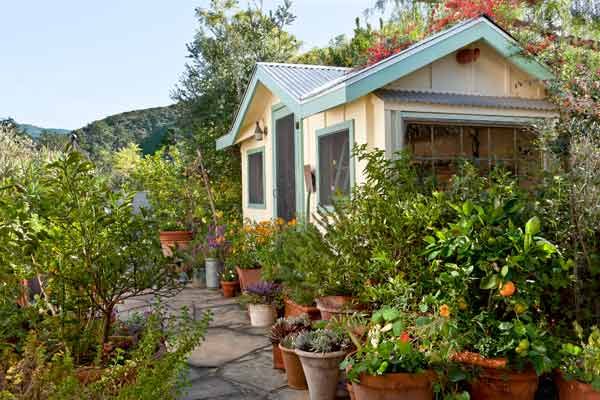
A garden shed can be more than a place to store rakes and trowels. It can serve as an extra workspace, a hobby room, or even a retreat, a place to get away from it all. Whatever activities go on inside, a primary consideration should be what it will look like on the outside, to ensure it’s a landscape enhancement, rather than an eyesore. That means getting the size and details right for the site, whether the shed stands off on its own at the back of the yard or sits up near the house.
Shown: With multipaned windows and board-and-batten siding, the shed at garden writer Sharon Lovejoy’s home looks like a cottage.
Paint: Benjamin Moore‘s Weston Flax (siding) and Waterbury Green (trim)
Multi-Use Work and Gardening Space
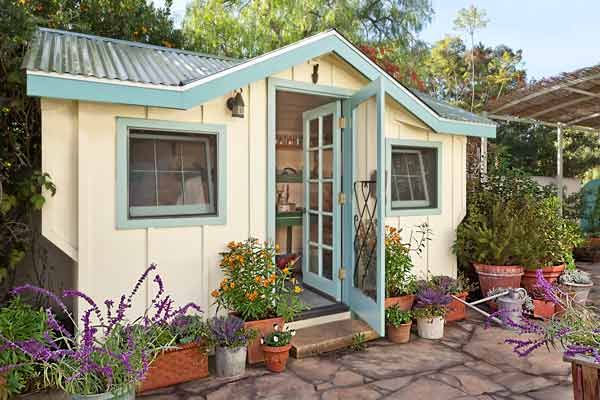
Sharon Lovejoy and Jeff Prostovich succeeded in creating the just-right shed, shown here, to support her passion for plants and the career she’s built as a garden writer, author, and illustrator. Christened “Sprig,” the shed holds some of the garden collectibles that inspire Sharon’s illustrations, gives her a place to dry herbs, and serves as a backup studio to her main workspace, an outbuilding in the backyard of the couple’s San Luis Obispo, California, home.
Shown: An old screen door repurposed from their previous house swings out; a multi-light door from ReStore swings in. Repurposed sashes tilt in for additional ventilation.
Outdoor Potting Area
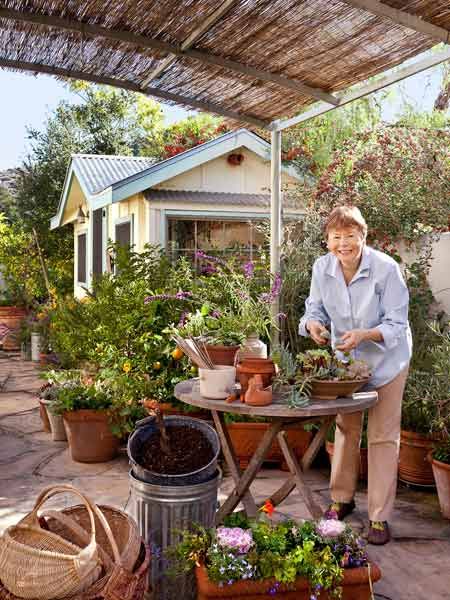
Once Sharon and Jeff decided to add a shed, they faced every homeowner’s first decision: where to put it. Almost every inch of their 85-by-110-foot lot was spoken for with the studio and established gardens that feed Sharon’s work. But there was an unused spot, about 7 by 12 feet, near the front of the house, just inside the stucco wall that surrounds the property. So they decided to build there, steps from their front door and next to a patio with a metal arbor, which they covered with inexpensive reed fencing for a shady potting area. In such a prominent place, “the shed’s proportions were very important,” says Jeff, a real-estate broker, who played chief designer on the project.
Shown: Home-center reed fencing turned a metal arbor above the flagstone patio into a shade structure for Sharon’s outdoor potting. A teak table serves as a potting bench for small projects; she just brushes or hoses it off when she’s done. Then the table resumes its original role, holding a cup of hot tea or a cool drink.
A Peek Inside
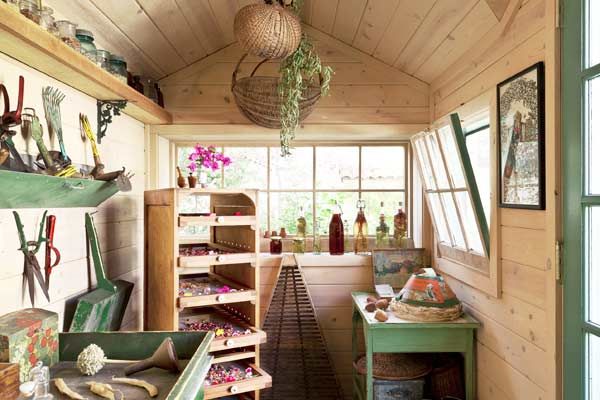
Rather than mimic the Spanish Revival style of their 1930 home, Jeff decided to complement it by making the shed look like a tiny traditional home, with a peaked roof, board-and-batten-style siding, and wood-framed windows. To provide an air gap between the shed and the wall, he shrank the shed’s depth to 6 feet 3 inches when he sketched a basic design, with a gable at each end of the long dimension. Then he tested his design by erecting a frame of 2x4s and scrap wood. “Drawing it out is one thing,” he says. “Seeing it is different.” To keep the scale right, he decided to make the walls just 7 feet high. “Eight feet would have looked odd with such a narrow space,” he says. “I didn’t want a tumor sitting in the front yard.”
Shown: Flowers fill the screen trays of a drying rack that was custom-made for Sharon. To the right of it is an old fruit-drying rack that she uses to dry everything from plums to peppers to marigold blossoms.
Seed Packets as Art
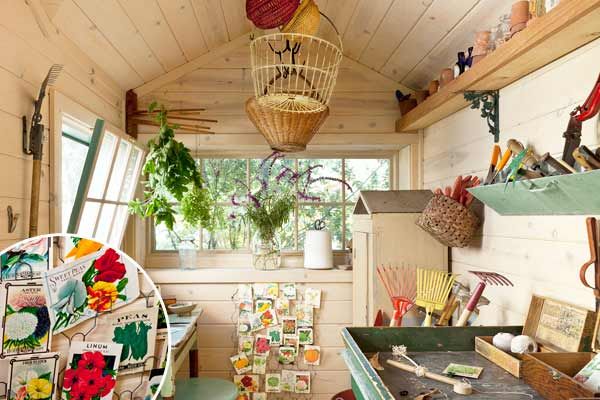
When sheds have short walls, the door typically goes on one gable end to keep it from bumping into the roof overhang. But for this shed, the door needed to be on the side facing the front door of the house. Jeff solved the problem by adding an extra gable over the door. To keep the walls from seeming low and to boost the usable space within the tiny structure, he left the ceiling vaulted to the roof. He also bumped out the windows on both ends, creating foot-deep windowsills to serve as storage ledges. Happy at last with the shed’s design, the couple hired pros to build it.
Shown: Sharon uses an old card rack to display vintage seed-packet graphics that she enjoys as “miniature works of art.”
Storage Worth Showing Off
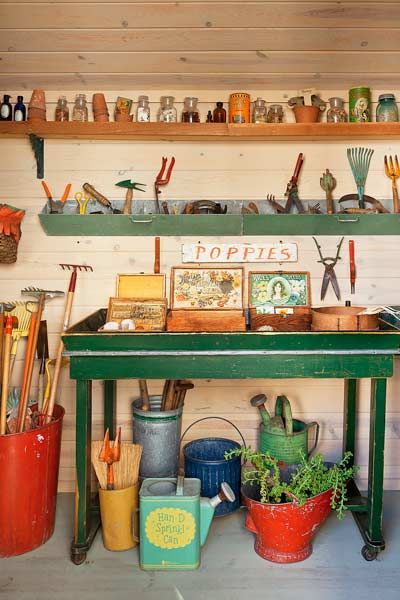
For the foundation, the builders used precast concrete pier blocks. Even in regions where the soil freezes, garden sheds usually do fine with this type of foundation; the building may get slightly askew as the soil thaws, but its small size keeps such changes small, too, and sheds typically settle back into shape. The crew built the floor with pressure-treated framing resting on the piers. Off that, they assembled the walls, using exterior-grade plywood with spaced 1×2 boards on top to mimic board-and-batten siding. Plywood sheets are easy to install and more weathertight than traditional board-and-batten, which uses wide boards with narrow ones nailed on over the joints.
Shown: The top shelf along the shed’s back wall stores tiny pots, plant labels, and other small items. Below it, two trough-type chicken feeders serve as bins for old and new garden tools.
Vintage Seed Storage
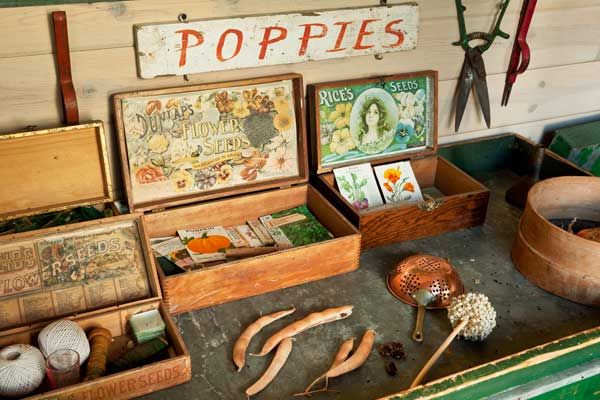
To create a vintage look—and save money— Sharon and Jeff shopped for true divided-light windows at their local ReStore, hinging the sashes of old double-hungs to tilt in on the long walls. Their big score was the fixed windows at the gable ends; the two new double-pane windows, worth $600 or more each, were priced at just $50—likely custom units that were donated because they were the wrong size. The roof is simple corrugated metal. Knotty pine covers the interior: 1×12 boards butted together on the floor and 1×6 V-groove boards on the walls. In total, with $4,800 for labor and $3,800 for materials, the project cost $8,600—not as cheap as a big-box shed kit, but, then, it’s a tailored-to-fit job with an ultra-charming look.
Shown: On an old Amish berry-sorting table, vintage seed boxes, still with their original artwork, make fine storage containers for new seeds as well as twine. A bin to the left of the table stores small garden tools perfect for the grandkids. Under the table are vintage watering cans, affordable collectibles still readily found at flea markets and yard sales.
Backup Art Studio
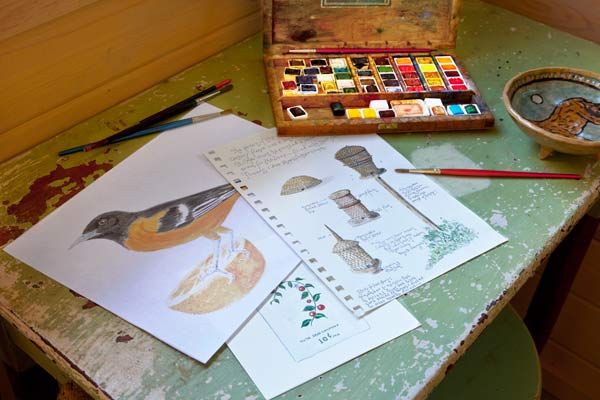
Sharon is in the shed most days, puttering among her treasures and creating her herb concoctions—it’s an “away” spot that fuels her work. “A playhouse…is what I always wanted when I was a child,” she wrote, once the project was completed. “My own little house in which I could hide, dream, draw, and make entire worlds of my own.” As she’s made apparent, a garden shed can be that, too.
Shown: The shed also accommodates Sharon’s artwork, as a sort of backup studio. Here, a small green table holds her watercolor of a Baltimore oriole that appears in her latest work, My First Bird Book and Bird Feeder (Workman, 2012).
Growing and Drying Herbs
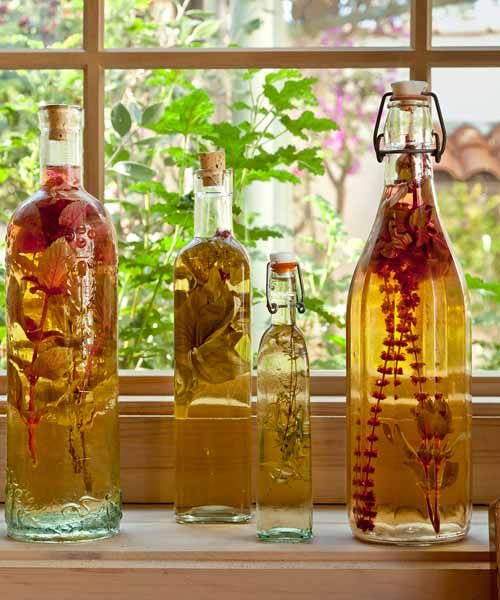
Packed into tiny jars in a supermarket spice aisle, a few teaspoons of dried herb leaves can be amazingly pricey. But grow and dry your own, as Sharon Lovejoy does, and you get the same thing virtually free. It’s easy.
Shown: Sharon makes her own herb-infused vinegars for salad dressing and marinades—and for giving as gifts. Thai basil, on the far right, is one of her favorite flavorings; shallot and chive blossom are others.
Screen Racks for Drying Flowers
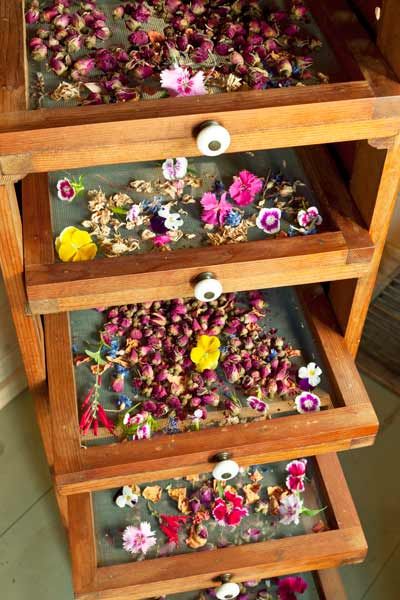
Many common herbs, including thyme, rosemary, marjoram, tarragon, and lavender, come from the Mediterranean region. Summers are warm and dry there, so the plants are naturally adapted to getting little summertime water. Soil that stays damp for long periods makes their roots rot. Providing soil that’s dry enough is easy in Southern California, but it’s trickier where summers are rainy. The solution: Grow them in unglazed terra-cotta pots that allow moisture to evaporate through the clay walls. Since herbs become gangly and need frequent snipping, Sharon turns the trimmings into dried herb blends, including a lavender and rose-petal mix for tea and a confectioner’s sprinkle of Viola tricolor for ice cream.
Shown: Sharon uses her screen racks to dry flower heads, including rosebuds, lavender, violas, red salvia, and pinks.
Herb Drying Basics
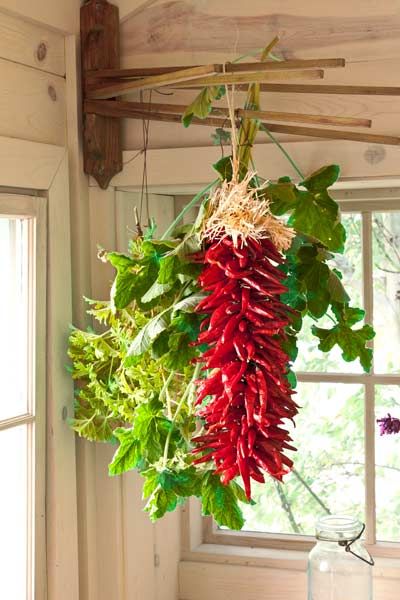
Drying herbs doesn’t require special equipment. Just hang stems upside down in loose bundles, out of direct sunlight. Keep bundles small; big ones tend to get moldy. Hang bunches far enough apart for air to circulate. When sufficiently dry, the leaves will crunch when you squeeze them—the quickest way to separate them from the hard stems. To preserve the most scent or flavor, store the dried leaves in airtight containers in a cool, dry, dark place.
Shown: An old laundry-drying rack with spreading arms is put to use to dry fresh bundles of scented geranium (Pelargonium) leaves and even hot peppers.
Hooks for Herb Bundles and Baskets
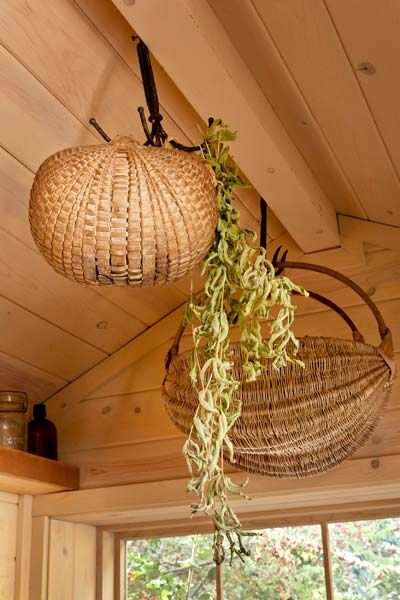
Antique hooks along the ridge beam have room for more dried herb bundles; they also come in handy for storing the big melon-shaped baskets she uses for harvesting fruit from the citrus trees she grows out back.
